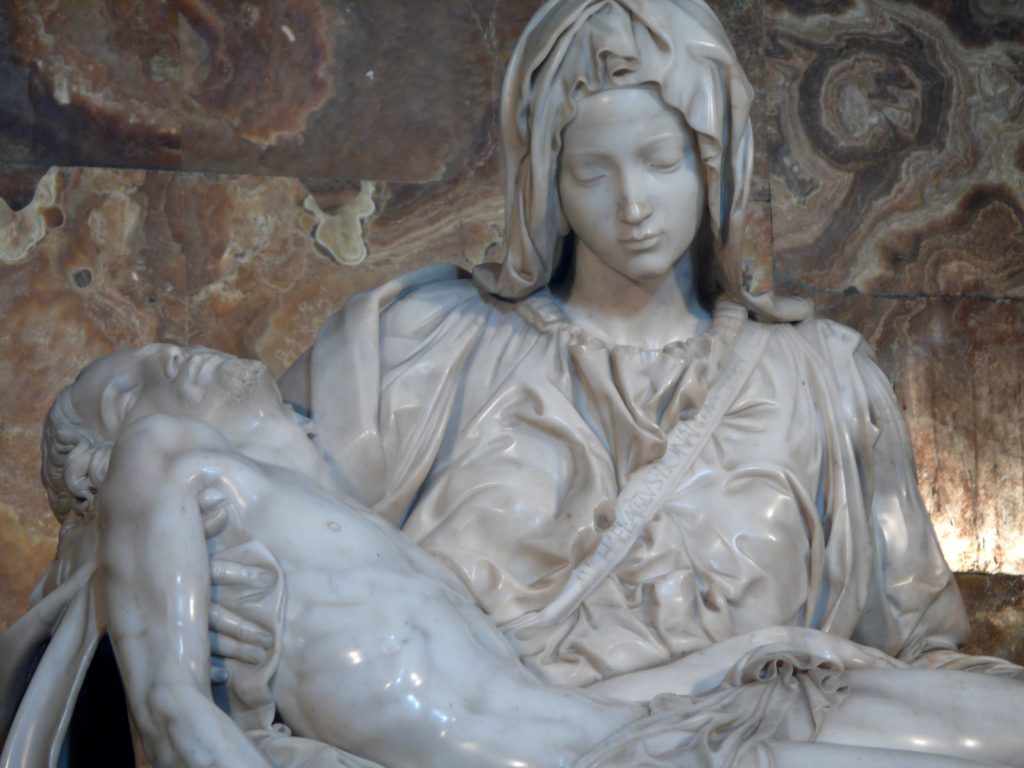In 1972 a mad man hammered Michelangelo’s Pietà
On May 21st 1972, the day of Pentecost, a 34 years old Australian geologist of Hungarian origin named László Tóth, evading surveillance, managed to hit Michelangelo’s work with a hammer fifteen times, kept in St. Peter’s Basilica in Rome. This is what happened that day, which forever changed the methods of surveillance of the masterpieces of art.
The Pietà suffered very serious damage, especially on the Virgin: the blows of the hammer had detached about fifty fragments, breaking the left arm and shattering the elbow, while on the face the nose had been almost destroyed, as well as the eyelids. The restoration was started almost immediately, after a study phase, and was carried out by reusing as much as possible the original fragments, as well as a mixture based on glue and marble dust. The author of the scar was recognized as mentally ill. Since then, the Pietà has been protected by a special bulletproof crystal wall.
On July 22nd 1971 Tóth arrived in Italy, in Rome, where he first found accommodation at the youth hostel in the Foro Italico and then in the Gianicolense district, in the dormitory of the Spanish nuns. During the summer of 1971 he went to St. Peter’s, in the Vatican City, insistently asking to see the then Pope Paul VI, claiming to be Jesus Christ himself: following this behavior he was blocked by the Vatican authorities and repatriated to Australia. being listed as an “undesirable person”. According to the article published by L’Unità, however, Tóth remained in Italy for 10 months before committing the vandalism.

László entered St. Peter’s Basilica on the morning of May 21st 1972 and, at around 11:30 am suddenly stepped over the balustrade that separated the crowd of visitors from the sculpture of the Pietà. He was dressed in a heavy blue jacket, like a raincoat, and a red shirt; tall and slender, he wore long hair and a short blond beard. Taking off his jacket to be freer in his movements, with a geologist’s hammer he first hit the head of the Madonna and then, several times, her face and arms, leaving the figure of Christ intact. As he did so, he shouted, in Italian: “Christ is risen! I am the Christ! ”.

Tóth was then stopped by a policeman, Marco Ottaggio, with the help of other overseers, and taken away, stolen from the angry crowd who intended to beat him. He was questioned later, although during the vandalism he had proclaimed sentences in Italian, he declared that he did not understand the questions that were being asked, claiming that he can only speak English.

According to other sources, however, he repeated disconnected phrases for all the interrogations, remaining in his conviction that he was the Christ: he even went so far as to say “What is this statue doing here? Christ is me and I am alive, I am the reincarnated Christ, destroy all his simulacra ”. Despite the deed, he was not indicted, but was interned in an asylum for two years. He was later repatriated to Australia. The Pietà was restored by the Scientific Research Cabinets of the Vatican Museums.
The Pietà di San Pietro (or Vaticana), made by Michelangelo Buonarroti when he was 20 years old, is now located in the basilica of San Pietro in the Vatican, and was sculpted between 1497 and 1499. It is one of the great masterpieces of art. world. The Pietà is now located in St. Peter’s Basilica in the Vatican, protected by a special bulletproof crystal wall. This is the only work of art that bears the author’s signature.

During Michelangelo’s first stay in Rome, from 1496 to 1501, the artist forged a relationship of friendship and collaboration with the banker Jacopo Galli, who acted as an intermediary and guarantor in various commissions linked to a group of cardinals. One of the most prestigious was the one for the marble Pieta for the French cardinal Jean de Bilhères, ambassador of Charles VIII to the Vatican.
In 1497 Michelangelo received a third of the five hundred ducats agreed as an advance to start the work. He left for Carrara to choose a piece of marble of excellent quality. The statue was ready in 1499 and destined for the chapel of Santa Petronilla. The work immediately aroused great admiration and Michelangelo signed it only later, when he heard two men praise the statue but attribute it to the Lombard sculptor Cristoforo Solari.
Shortly before 1517 the work was moved to the sacristy of St. Peter’s Basilica in the Vatican. Its current location, in the first chapel to the right of the nave of the basilica, dates back to 1749. In 1964 the Pietà was lent by the Holy See to the New York World’s Fair 1964 (the Universal Exposition of New York). It was the only time it was moved from St. Peter’s Basilica.
